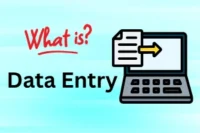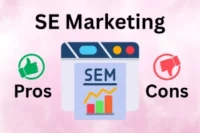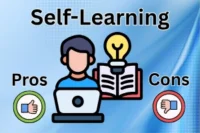15+ Main Types of Email Marketing Campaigns
Published: 15 Oct 2025
Guys, do you know what is email marketing?
In simple terms, email marketing involves using emails to promote products or services, build relationships with customers, and drive sales. It’s a powerful type of digital marketing.
But did you know there are different types of email marketing, each serving a unique purpose with its own set of advantages and limitations?
In this article, we’ll delve into each type, exploring how they work and when to use them effectively.
Types of Email Marketing
There are different types of email marketing campaigns. In this section we will be looking up on each type of email campaign in detail.
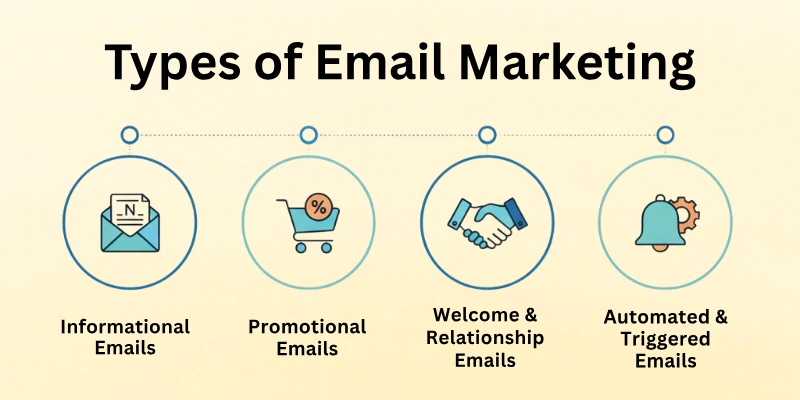
- Welcome Emails
- Promotional Emails
- Newsletter Emails
- Transactional Emails
- Behavioral Emails
- Re-engagement Emails
- Seasonal Campaign Emails
- Survey Emails
- Lead Nurturing Emails
- Event Invitation Emails
- Post-Purchase Emails
- Dedicated Emails
- Milestone Emails
- Review Request Emails
- Content Digest Emails
- Announcement Emails
- Apology Emails
Let’s start covering each in detail.
Welcome Emails
Welcome emails are the first emails you send to new subscribers or customers. They introduce your brand, set expectations, and often provide a warm greeting. These emails help create a positive first impression and start building a relationship with the recipient.
When to Use
Use welcome emails right after someone subscribes to your newsletter, signs up for your service, or makes their first purchase. This immediate response shows appreciation and helps engage the new subscriber or customer.
What is the Format
A typical welcome email includes:
- A friendly greeting
- A brief introduction to your brand
- Information on what to expect from future emails
- A call-to-action (CTA), like exploring your website or following on social media
- Contact information for any questions or support
Advantages
- Creates a positive first impression
- Helps build a connection with new subscribers or customers
- Sets expectations for future communications
- Can increase engagement
Disadvantages
- If not well-crafted, it may seem impersonal or generic
- Overloading with information can overwhelm the recipient
- Not sending it promptly can lose the initial interest of the subscriber or customer
Promotional Emails
Promotional emails are designed to promote products, services, or special offers to your subscribers. These emails aim to encourage recipients to make a purchase, take advantage of a discount, or engage with a special offer. They often include clear calls-to-action (CTAs) to drive conversions.
When to Use
Use promotional emails when you have a special offer, sale, or new product launch. They are also effective during holiday seasons, end-of-season sales, or any time you want to boost sales and attract customer attention.
What is the Format
A typical promotional email includes:
- A catchy subject line
- A brief and engaging introduction
- Details about the promotion or offer
- High-quality images of products or services
- Clear and compelling CTAs (e.g., “Shop Now,” “Get 20% Off”)
- Terms and conditions of the promotion, if any
Advantages
- Drives sales and revenue
- Attracts customer attention to new products or offers
- Can be targeted to specific segments for higher relevance
- Easy to track and measure effectiveness through metrics like open rates and conversion rates
Disadvantages
- Too many promotional emails can lead to higher unsubscribe rates
- If not well-targeted, they may be perceived as spam
Newsletter Emails
Newsletter emails are regular updates delivered to subscribers to keep them up to date on your brand, industry news, blog posts, upcoming events, and other relevant stuff. They hope to establish relationships by offering value through useful and interesting content.
When to Use
Use newsletter emails on a consistent schedule, such as weekly, bi-weekly, or monthly. They are ideal for keeping your audience engaged about what’s happening in your business and niche.
What is the Format
A typical newsletter email includes:
- A clear and engaging subject line
- A personalized greeting
- Highlights of key content or news
- Brief summaries and links to full articles or blog posts
- High-quality images or graphics
- CTAs encouraging further engagement (e.g., “Read More,” “Join the Event”)
- Contact information and social media links
Advantages
- Keeps your audience engaged and informed
- Builds and maintains strong relationships
- Provides a platform to share a variety of content in one email
- Can drive traffic to your website
Disadvantages
- Requires regular content creation
- If content is not relevant, it may lead to lower open rates
- Balancing the amount of information to avoid overwhelming the reader can be challenging
Transactional Emails
Transactional emails are automated emails triggered by specific actions taken by a user, such as making a purchase, signing up for an account, or requesting a password reset. These emails provide necessary information and confirmations about these transactions.
When to Use
Use transactional emails whenever a user completes a significant action on your website or app, such as placing an order, changing their account settings, or completing a form. They ensure users receive important information related to their activities.
What is the Format
A typical transactional email includes:
- A clear subject line indicating the purpose (e.g., “Order Confirmation,” “Password Reset”)
- Personalized greeting
- Details of the transaction (e.g., order summary, account changes)
- Clear and concise information on next steps or additional actions
- Contact information for support
Advantages
- Provides essential information and confirmations
- Builds trust
- High open and engagement rates
- Can include additional information to enhance user experience
Disadvantages
- Limited scope for creativity as the primary focus is on transactional details
- Requires reliable systems to ensure timely and accurate delivery
Behavioral Emails
Behavioral emails are automatic emails that are sent when users perform specified activities or behaviors on your website or app. These emails are highly customized and targeted based on user behavior, such as exploring specific products, quitting a cart, or spending a lot of time on a specific page.
When to Use
Use behavioral emails to engage users based on their interactions with your site or app. Examples include sending cart abandonment reminders, recommending products based on browsing history, or re-engaging inactive users.
What is the Format
A typical behavioral email includes:
- A personalized subject line and greeting
- Contextual content related to the user’s recent behavior (e.g., “You left items in your cart,” “Based on your interest in…”)
- Relevant recommendations or reminders
- Clear CTAs encouraging the desired action (e.g., “Complete your purchase,” “Check out these recommendations”)
- Any additional incentives or discounts to motivate action
Advantages
- Highly personalized and relevant to the user
- Can improve engagement and conversion rates
- Efficient in re-engaging inactive users and reducing cart abandonment
Disadvantages
- Requires tracking and analyzing
- Over-personalization may feel unwanted
Re-engagement Emails
Re-engagement emails are targeted emails delivered to inactive subscribers or consumers to regain their interest in your business. The idea is to re-engage them by reminding them of your value, providing benefits, or seeking feedback on why they have been inactive.
When to Use
Use re-engagement emails when subscribers or customers have not interacted with your emails or services for a certain period. This could be after a few months of inactivity or when they haven’t made a purchase in a while.
What is the Format
A typical re-engagement email includes:
- A personalized subject line
- Acknowledgment of their inactivity (e.g., “We Miss You!”)
- A reminder of the benefits of your products or services
- Special offers to encourage re-engagement (e.g., discounts, exclusive content)
- A clear CTA to prompt action (e.g., “Come Back,” “Reactivate Your Account”)
- Optionally, a request for feedback to understand their inactivity
Advantages
- Helps recover inactive subscribers
- Boosts customer retention
- Shows that you care about your customers’ engagement and satisfaction
Disadvantages
- May not always be successful in re-engaging inactive users
- Requires careful timing and relevance to avoid further disengagement
- Sending too many re-engagement emails can lead to higher unsubscribe rates
Seasonal Campaign Emails
Seasonal campaign emails are promotional emails sent around specific holidays, seasons, or events to capitalize on the increased interest and spending during these times. They are designed to highlight special offers, discounts, or seasonal products relevant to the occasion.
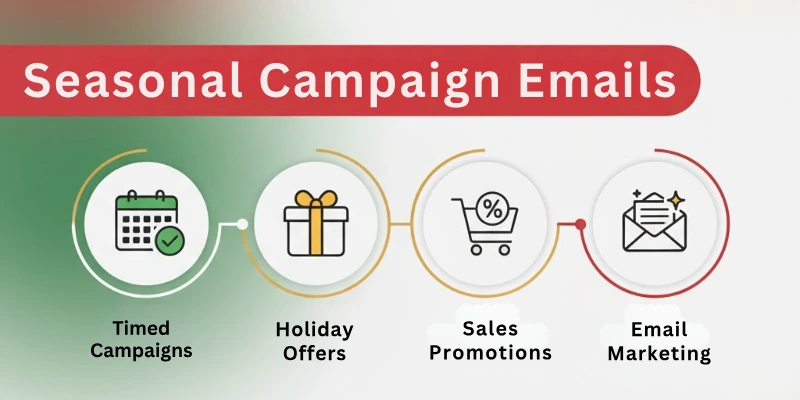
When to Use
Use seasonal campaign emails during major holidays (e.g., Christmas, Thanksgiving, Easter), seasonal events (e.g., back-to-school, summer sales), and special occasions (e.g., Black Friday, Valentine’s Day). Timing is crucial to align with the relevant season or event.
What is the Format
A typical seasonal campaign email includes:
- A festive and eye-catching subject line
- A greeting that acknowledges the holiday or event
- Highlights of special offers, discounts, or seasonal products
- Engaging images or graphics related to the season
- Clear and compelling CTAs (e.g., “Shop Now,” “Get Your Holiday Discount”)
- Information on the duration of the offer or campaign
Advantages
- Increased consumer during holidays and events
- Creates a sense of urgency and excitement
- Can attract new customers and re-engage existing ones
Disadvantages
- Highly competitive, as many brands send similar emails during these times
- May not appeal to all segments of your audience equally
Survey Emails
Survey emails are emails sent to customers or subscribers to gather feedback on their experiences, preferences, or opinions. These emails typically include a link to an online survey form where recipients can provide their input.
When to Use
Use survey emails to collect valuable feedback after a customer interaction, such as a purchase, service experience, or event participation.
What is the Format
A typical survey email includes:
- A clear subject line indicating the survey’s purpose
- A brief explanation of why the survey is important
- A link or button to the survey form
- An incentive for completing the survey (optional), such as a discount or entry into a prize draw
- A thank you message for their participation
Advantages
- Provides direct feedback from customers
- Demonstrates that you value customers’ opinions
- Can uncover issues or areas for improvement
Disadvantages
- Low response rates
- Requires careful question design to obtain information
Lead Nurturing Emails
Lead nurturing emails are a series of emails sent to clients to help them go through the selling process by establishing a relationship and delivering important information that answers their pain points. The goal is to eventually convert leads into customers.
When to Use
Use lead nurturing emails after capturing a lead’s contact information, such as through a signup form, content download, or webinar registration. These emails are typically sent over a period of time to gradually engage and educate the lead.
What is the Format
A typical lead nurturing email includes:
- A personalized subject line
- Relevant and valuable content
- Educational resources such as articles, case studies, eBooks, or videos
- Clear CTAs encouraging the lead to take the next step (e.g., “Learn More,” “Schedule a Demo”)
- Links to additional resources like your website
Advantages
- Builds trust
- Addresses the specific needs of leads
- Increases the chances of converting leads into customers
- Can be automated for consistency
Disadvantages
- Requires well-planned content that is relevant to the lead’s stage
- Over-communication can turn off leads
- May take time to see results
Event Invitation Emails
Event invitation emails are emails sent to invite recipients to attend a specific event, such as a webinar, conference, product launch, or networking event. These emails provide details about the event and encourage recipients to RSVP or register.
When to Use
Use event invitation emails when organizing an event and you want to notify your audience and encourage attendance. Timing is crucial to give recipients enough notice and time to respond.
What is the Format
A typical event invitation email includes:
- A compelling subject line that grabs attention and indicates the nature of the event
- A personalized greeting addressing the recipient by name
- Details about the event, including date, time, location (if physical), and agenda
- Highlights of key speakers, topics, or activities
- Clear instructions or CTAs to RSVP or register (including a link to the registration page)
- Contact information for inquiries or assistance
Advantages
- Directly invites recipients to participate
- Increases event attendance
- Builds excitement around the event
Disadvantages
- Requires careful timing to ensure recipients have enough time to respond
- Overuse of event invitations can lead to recipient fatigue
- Needs effective follow-up strategies to maximize attendance
Post-Purchase Emails
Post-purchase emails are sent to customers after they make a purchase. These emails aim to thank the customer, confirm the order, and provide important information about the purchase.
When to Use
Use post-purchase emails immediately after a customer completes a purchase. These emails can be part of a series, including order confirmation, shipping updates, and follow-ups to request feedback or suggest related products.
What is the Format
A typical post-purchase email includes:
- A greeting thanking the customer
- Order confirmation details, including items purchased, prices, and order number
- Shipping information with tracking details, if applicable
- Instructions on what to do next (e.g., how to access digital products, return policies)
- An invitation to provide feedback or a review
- Contact information for customer support
Advantages
- Positive customer experience and builds brand loyalty
- Provides essential information and reassurance about the purchase
- Encourages repeat purchases
- Can gather valuable customer feedback
Disadvantages
- Requires timely information to maintain customer satisfaction
- Overloading with promotional content can reduce the effectiveness of the primary message
Dedicated Emails
Dedicated emails, also known as standalone emails, focus on a single offer, event, or message, rather than including multiple topics. These emails are designed to highlight a specific piece of content or promotion.
When to Use
Use dedicated emails when you have a specific promotion, product launch, event, or important message that requires the full attention of your recipients with immediate action or response.
What is the Format
A typical dedicated email includes:
- A clear subject line
- A focused message detailing the specific offer, event, or announcement
- High-quality images or graphics related to the content
- A single, clear CTA (e.g., “Shop Now,” “Register Today”)
- Additional relevant information, such as terms and conditions or event details
- Contact information for further inquiries
Advantages
- Highly targeted
- Can drive high engagement due to direct content
- Reduces the risk of bombarding the recipient with excessive information.
Disadvantages
- May lead to lower overall email frequency if overused
- Risk of being seen as too promotional if not balanced with other types of content
- Limited in scope, as it focuses on one subject rather than multiple topics
Milestone Emails
Milestone emails are emails sent to recognize and celebrate significant events or achievements in a customer’s journey with your brand.
When to Use
Use milestone emails to mark important dates such as the anniversary of a customer’s first purchase, their birthday, or the completion of a certain number of transactions. These emails help strengthen the relationship and show appreciation.
What is the Format
A typical milestone email includes:
- A personalized subject line and greeting
- Acknowledgment of the milestone being celebrated (e.g., “Happy Anniversary!” or “Congratulations on your 10th purchase!”)
- A celebratory message expressing appreciation
- Special offers or discounts as a reward for the milestone
- High-quality images to enhance the celebratory tone
- A clear CTA to encourage the recipient to take advantage of the special offer
- Contact information for any questions or support
Advantages
- Makes customers feel valued
- Encourages repeat business through special offers
- Enhances the overall customer experience
Disadvantages
- Requires accurate tracking of customer data
- Needs to be personalized and relevant to avoid seeming automated
Review Request Emails
Review request emails are emails sent to customers asking them to provide feedback or reviews on their recent purchase or experience with your product or service.
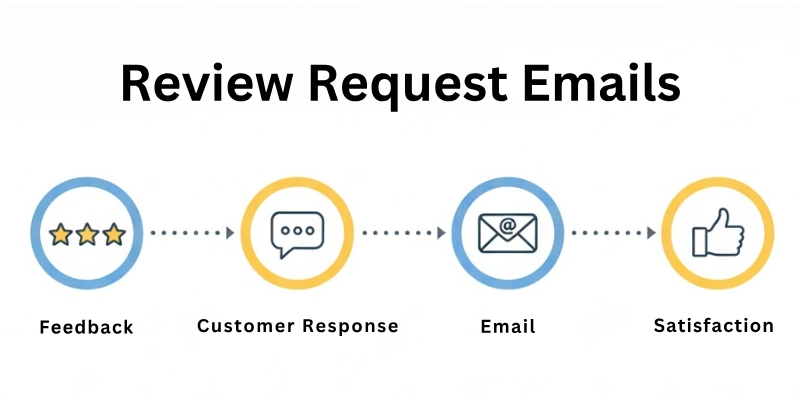
When to Use
Use review request emails after a customer has had sufficient time to use your product or service, typically a few days to a week after delivery or completion. Timing is crucial to ensure the experience is still fresh in the customer’s mind.
What is the Format
A typical review request email includes:
- A subject line and greeting
- A brief thank you message for their purchase
- A polite request for feedback or a review
- Clear instructions on how to leave a review, including links to review platforms or forms
- An explanation of why their feedback is valuable
- An optional incentive for leaving a review (e.g., a discount on future purchases)
- Contact information for any questions or support
Advantages
- Gathers valuable customer feedback
- Builds trust through authentic customer reviews
- Enhances online presence and SEO with user-generated content
Disadvantages
- Some customers may not respond, leading to a low response rate
- Needs a system in place to monitor and respond to reviews, especially negative ones
Content Digest Emails
Content digest emails are emails that curate and summarize multiple pieces of content, such as blog posts, articles, videos, or newsletters, into one comprehensive email.
When to Use
Use content digest emails regularly, such as weekly, bi-weekly, or monthly, to keep your audience engaged and informed about your latest content. They are ideal for sharing updates, roundups, and highlights from various sources.
What is the Format
A typical content digest email includes:
- A clear subject line
- A personalized greeting
- Brief summaries of the featured content
- Links to the full articles, videos, or posts
- High-quality images
- CTAs encouraging readers to explore more content (e.g., “Read More,” “Watch Now”)
- Optionally, categories or sections to organize different types of content
Advantages
- Keeps subscribers informed and engaged
- Increases website traffic
- Can boost engagement metrics like click-through rates and time spent on site
Disadvantages
- Requires regular content creation
- Risk of overwhelming readers with too much information
- Needs a balance between variety and focus to maintain reader interest
Announcement Emails
Announcement emails are emails sent to inform subscribers or customers about important news, updates, or changes related to your brand, products, or services.
When to Use
Use announcement emails when you have significant news to share, such as a new product launch, company updates, major changes to services, special events, or policy updates. Timing is crucial to ensure the information is relevant and timely.
What is the Format
A typical announcement email includes:
- A clear attention-grabbing subject line
- A concise and engaging introduction that highlights the main announcement
- Detailed information about the news or update
- High-quality images to enhance the message
- A clear CTA if action is required (e.g., “Learn More,” “Register Now”)
- Additional relevant details or links for further information
- Contact information for questions or support
Advantages
- Keeps subscribers informed
- Builds trust with your audience
- Drives engagement
- Provides a direct line of communication for major updates
Disadvantages
- Risk of low engagement if the announcement is not perceived
- Requires clear and concise messaging to ensure the main points are understood
Apology Emails
Apology emails are emails sent to customers or subscribers to acknowledge and apologize for a mistake, issue, or inconvenience they may have experienced. These emails aim to address the problem, express regret, and offer a solution or compensation.
When to Use
Use apology emails when your company has made an error, such as shipping delays, service disruptions, product defects, or any situation where customer expectations were not met. Timing is crucial to address the issue promptly and prevent further dissatisfaction.
What is the Format
A typical apology email includes:
- A clear and sincere subject line (e.g., “We Apologize for the Inconvenience”)
- A personalized greeting
- A sincere and straightforward apology
- A brief explanation of the issue (without making excuses)
- Steps being taken to resolve the problem and prevent it in the future
- Compensation or a gesture of goodwill (e.g., discounts, refunds)
- A clear CTA if further action is needed (e.g., “Contact Us,” “Claim Your Discount”)
- Contact information for additional support or inquiries
Advantages
- Helps to rebuild trust
- Shows willingness to make amends
- Can turn a negative experience into a positive one
Disadvantages
- Requires careful wording
- May not fully satisfy all customers, depending on the issue
- Repeated mistakes and apologies can damage brand worth
Conclusion
So guys, in this article, we have covered all the types of email marketing in detail, from their definitions to their disadvantages. I hope that now all your queries have been cleared up.
Advice: Always try to keep your emails simple and to the point, with a personal touch. As you have seen, in each customizing step, I have used the terms “personalized” and “straightforward message” with greetings. These little tips make your email campaigns more effective and easier to read.
Also guys, if you still have any confusion, you can comment below. I will be here to guide you.
FAQs
Here are some most commonly asked questions related to the types of email campaigns:
Yes, you can mix different types of emails. For example, you can send a newsletter that also includes a special offer. This makes your email more useful and interesting. Just don’t add too much so it stays easy to read.
Sending one or two emails each week is usually enough. It keeps people interested without annoying them. You can test what time works best for your readers. Always share something helpful or exciting.
Transactional emails go out after someone takes an action, like buying something or resetting a password. Promotional emails are for sharing offers or new products. One gives updates, the other encourages sales. Both are important for your business.
Not really. Behavioral emails are sent based on what someone does, like clicking or buying. Personalized emails use details like their name or location. Using both helps you send better and more relevant messages.
You can check how many people open your emails or click on your links. Also, see how many make a purchase or sign up. These numbers show what’s working well. Try to improve with every new email.
Use short, catchy subject lines to grab attention. Try sending emails at different times or days. Make sure your content fits what your readers like. Test small changes to see what works best.
Images can make your email look nice and interesting. But some people can’t see them, so add clear text too. Keep your images small so emails load fast. Always make sure the message is easy to understand.
Ask people to sign up by offering something useful, like tips or discounts. Add a simple form on your website. Always get permission before adding anyone. Keep your list clean and follow privacy rules.
Yes, many emails can be sent automatically, like welcome or thank-you messages. It saves time and keeps things running smoothly. You can also send reminders or updates this way. Just check them sometimes to keep them fresh.
Remove them from your list right away. Always respect their choice. You can ask why they left to learn and improve. Keeping your list clean helps you build trust.

- Be Respectful
- Stay Relevant
- Stay Positive
- True Feedback
- Encourage Discussion
- Avoid Spamming
- No Fake News
- Don't Copy-Paste
- No Personal Attacks

- Be Respectful
- Stay Relevant
- Stay Positive
- True Feedback
- Encourage Discussion
- Avoid Spamming
- No Fake News
- Don't Copy-Paste
- No Personal Attacks


